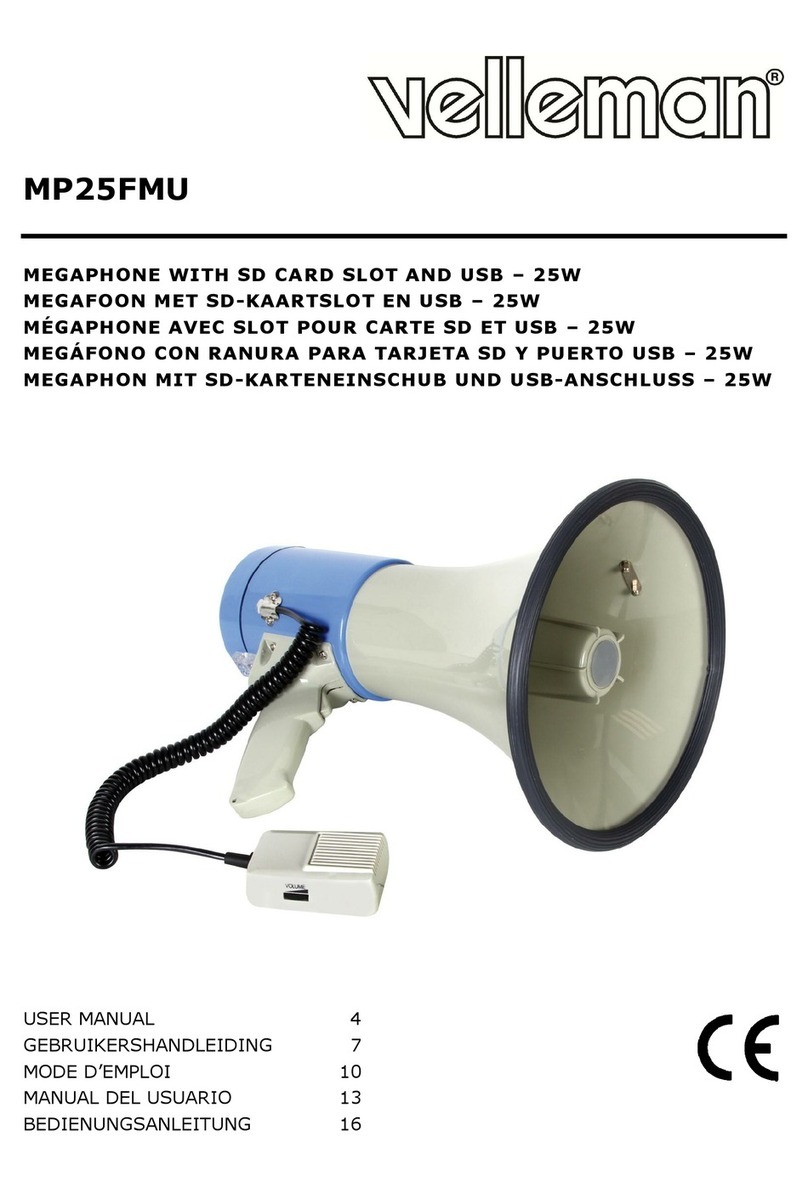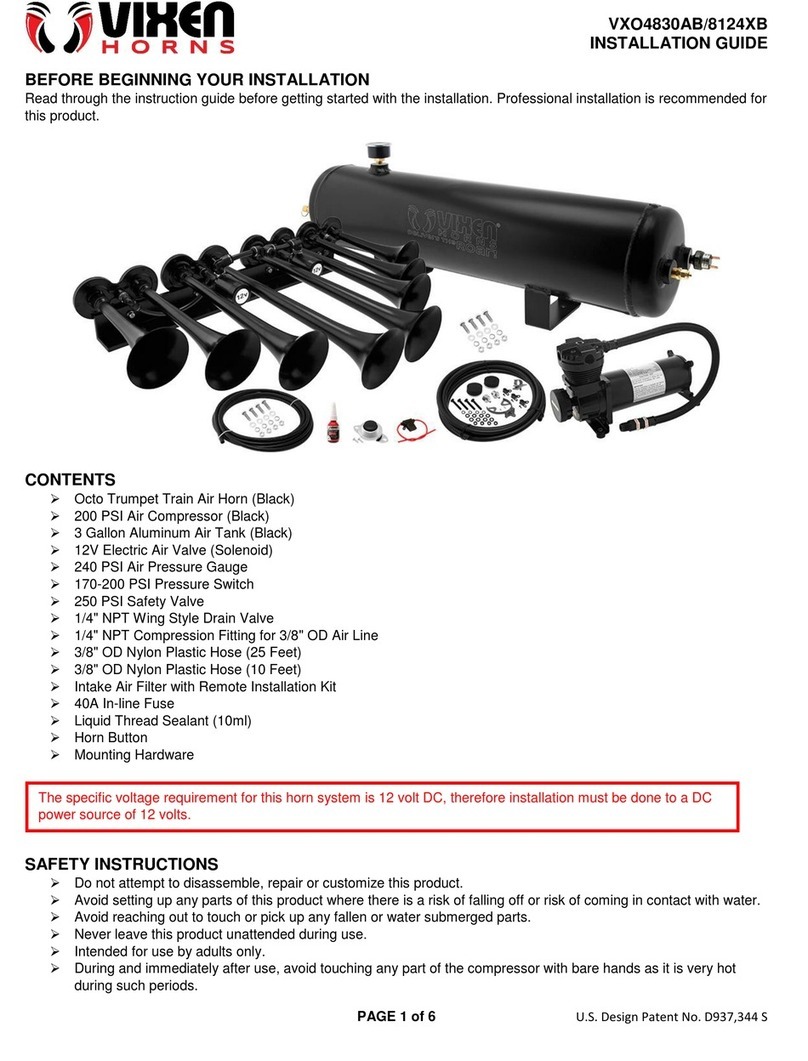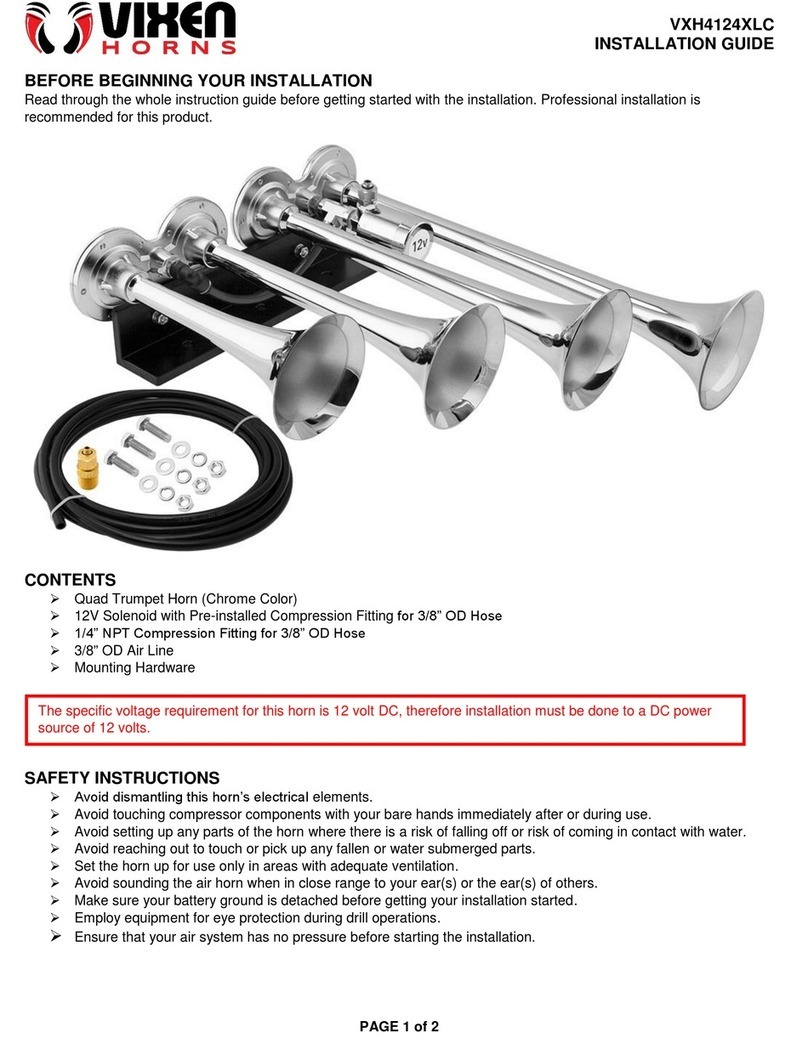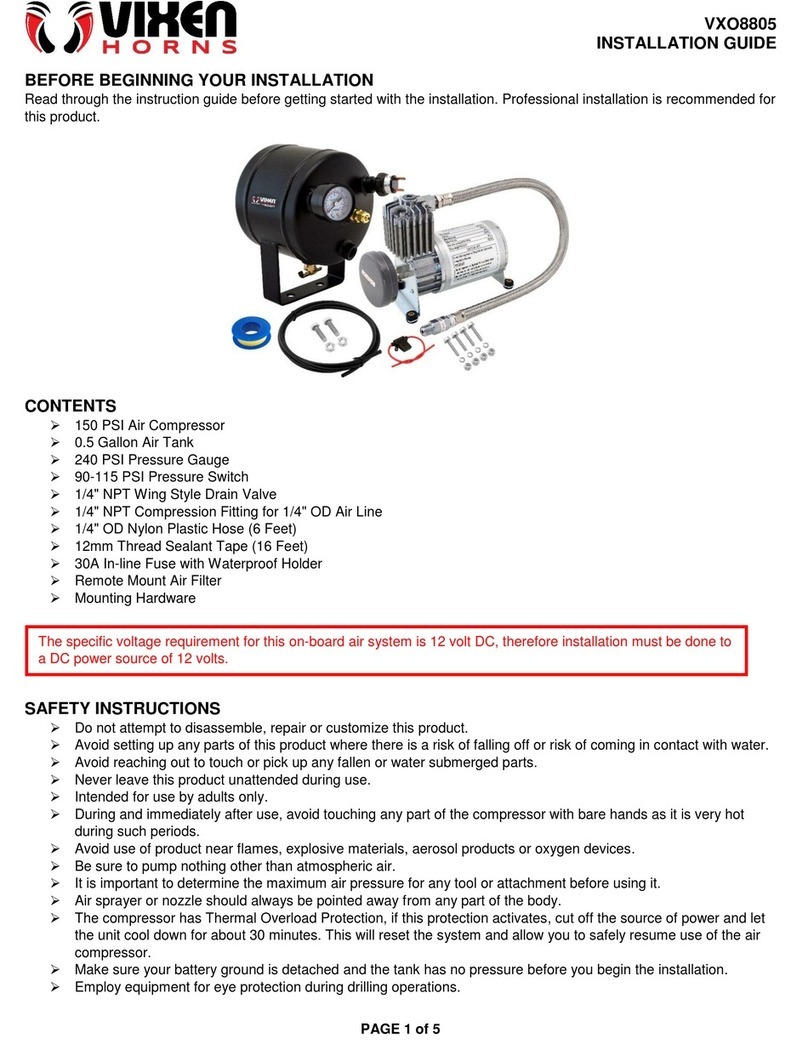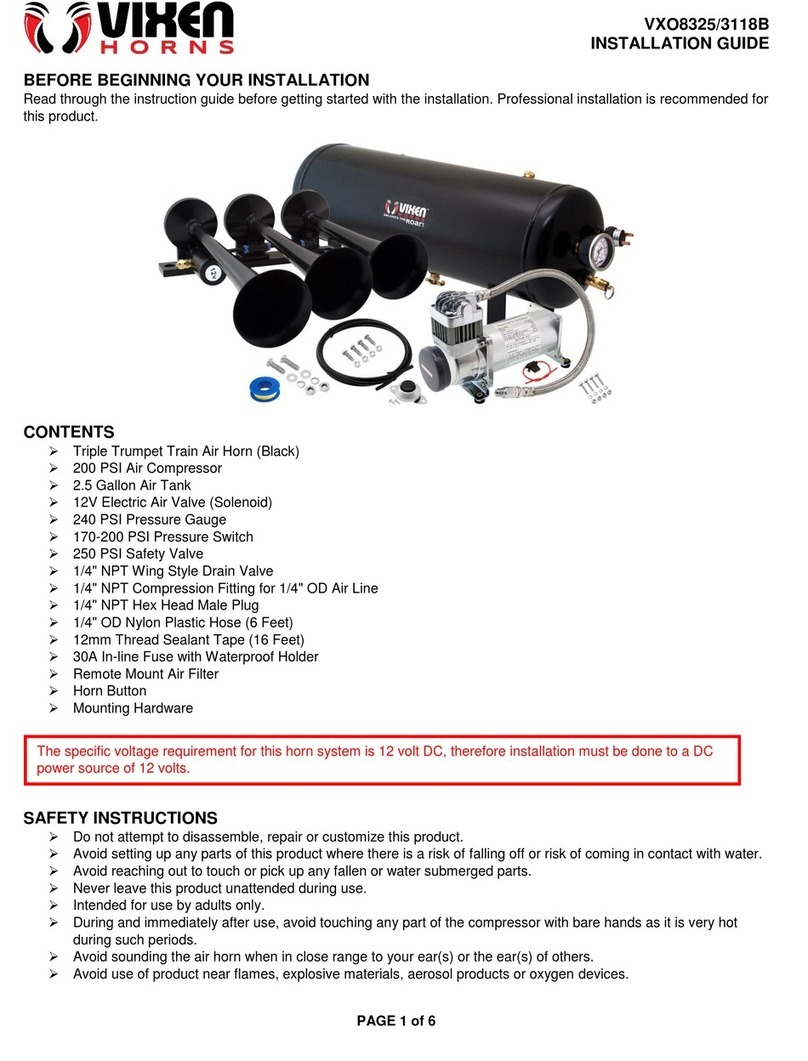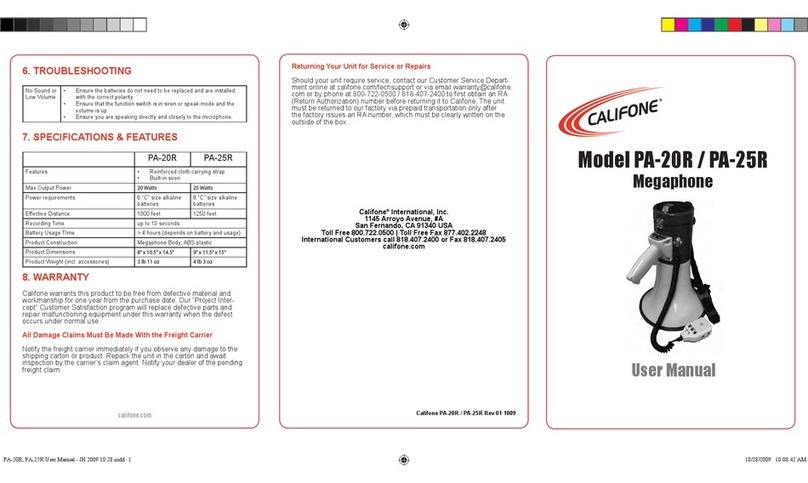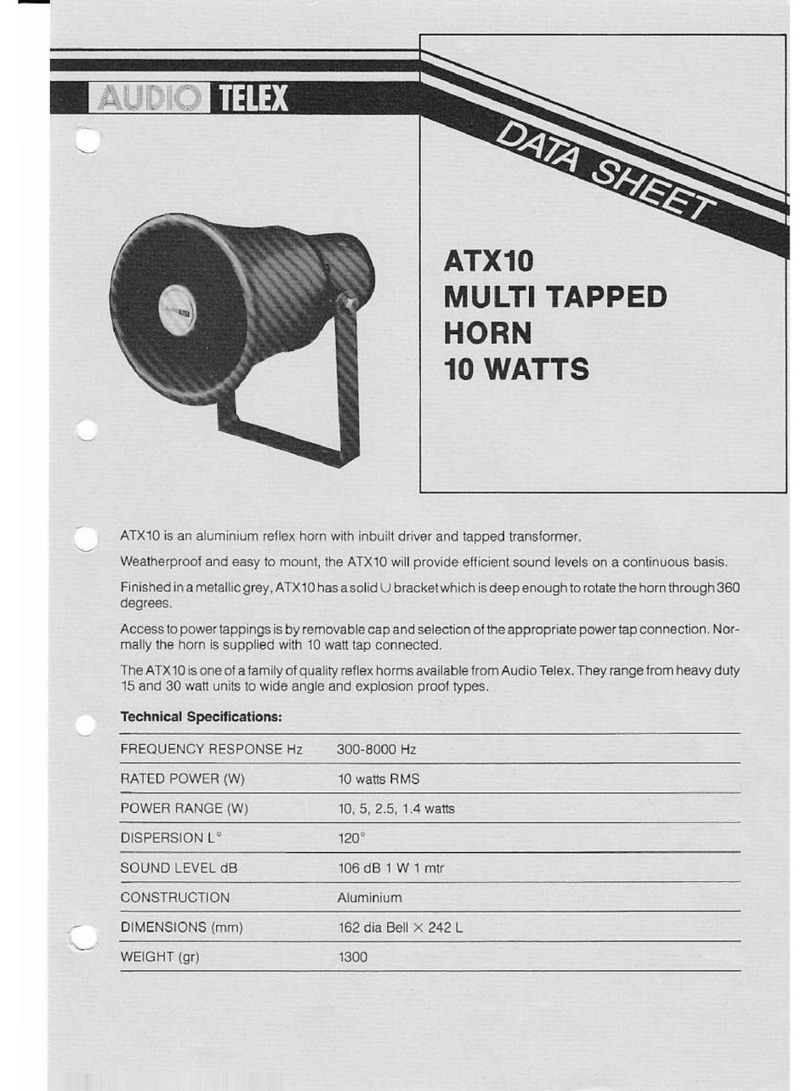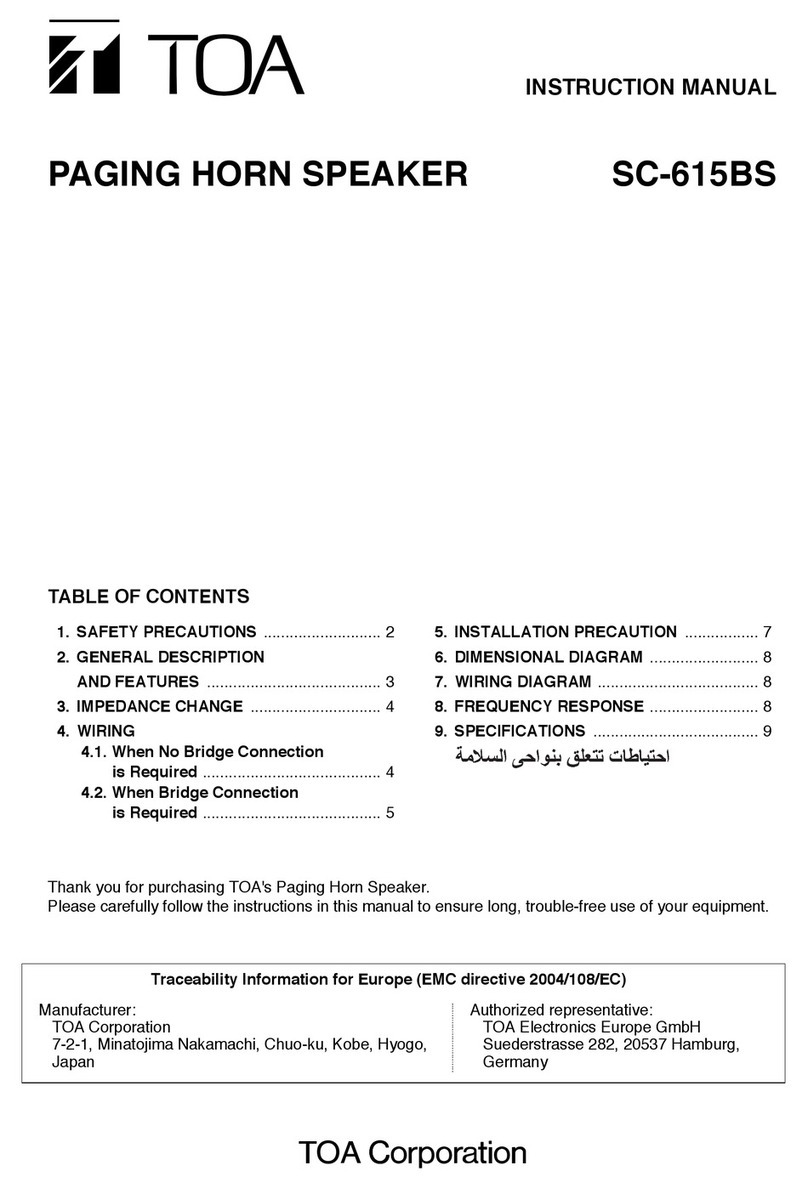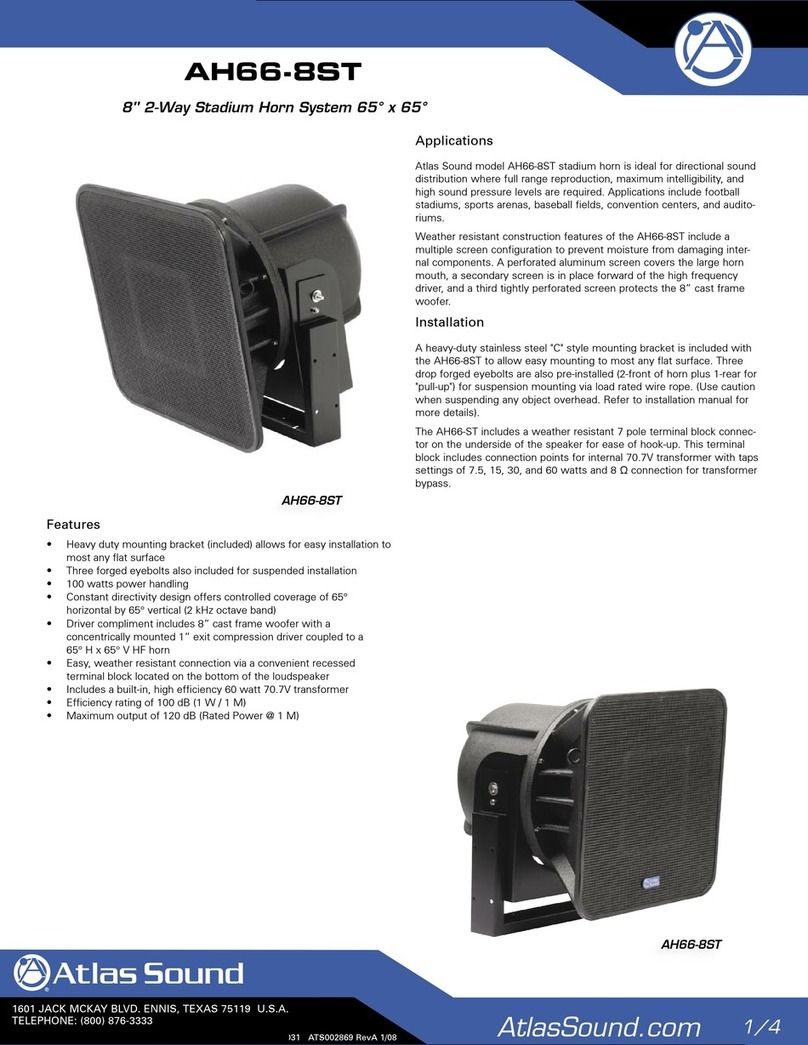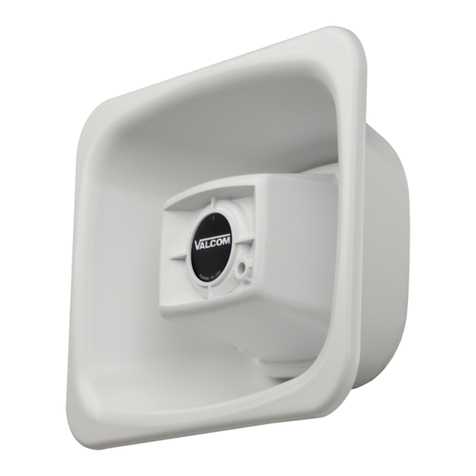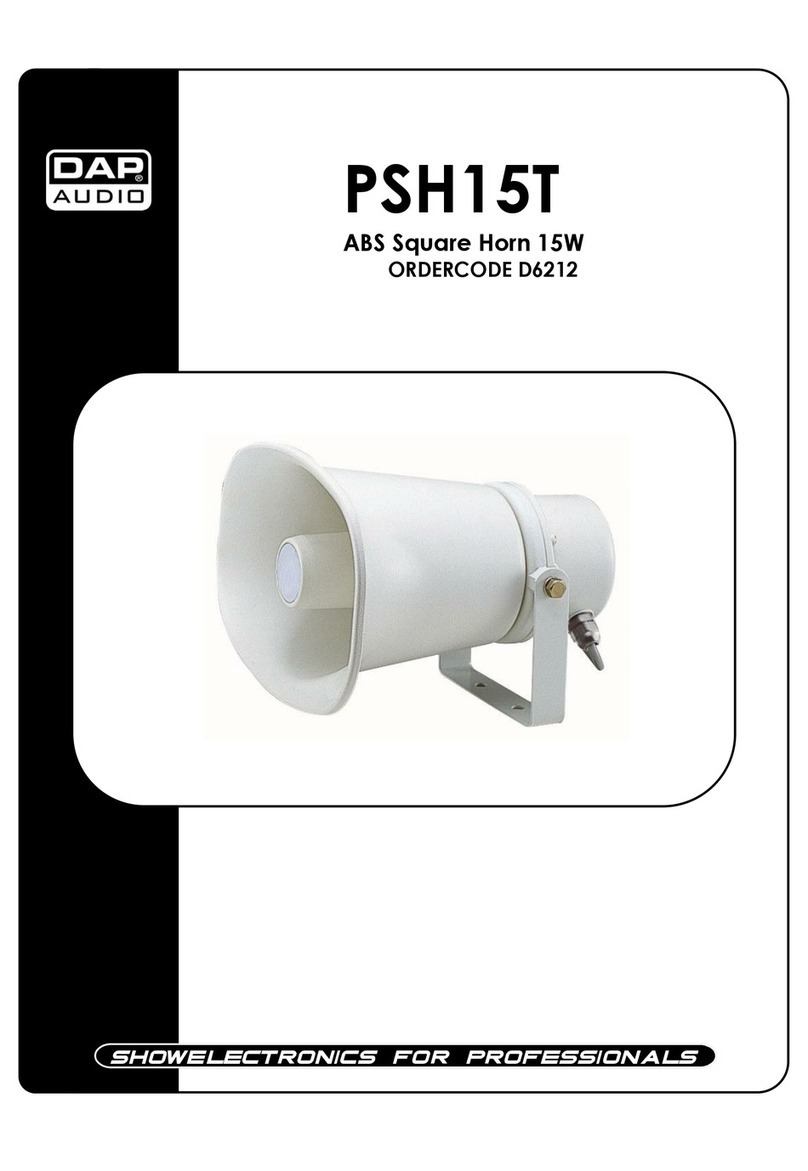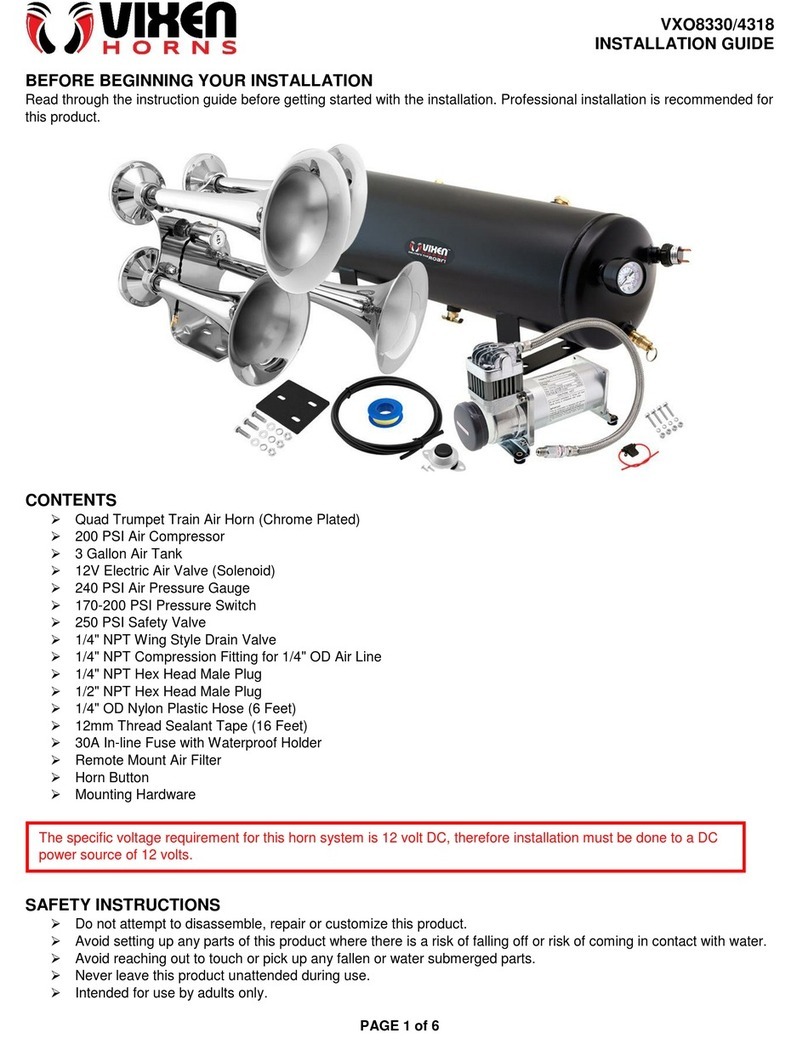TRIGA TR-HRL User manual

1 I56-5844TRG-002
2/1/2021
For use with the following models:
Horns: TR-HRL, TR-HWL
Compact Horns: HGRL, HGWL
Chimes: CHRL, CHWL
PRODUCT SPECIFICATIONS
Standard Operating Temperature: 32°F to 120°F (0°C to 49°C)
Humidity Range: 10 to 93% Non-condensing
Nominal Voltage: Regulated 12VDC or regulated 24DC/FWR
Operating Voltage Range (includes fire alarm panels with built in sync): 8 to 17.5V (12V nominal) or 16 to 33V (24V nominal)
Operating Voltage with MDL3 Sync Module: 8.5 to 17.5V (12V nominal) or 16.5 to 33V (24V nominal)
Input terminal wire gauge: 12 to 18 AWG
DIMENSIONS FOR PRODUCTS AND ACCESSORIES MOUNTING BOX OPTIONS
WALL PRODUCTS Length Width Depth
Horn and Chime Compact Horn
Horn/Chime
5.6" (143mm) 4.7" (119mm) 1.25" (32mm)
4" x 4" x 1½", Single Gang,
Double Gang, 4" Octagon,
SBBRL/WL
Single Gang,
SBBGRL/WL
Compact Horn
5.25" (133
mm) 3.45" (88 mm) 1.25" (32 mm)
Horn/Chime with SBBRL/WL
Surface Mount Back Box 5.9" (149 mm) 4.9" (125 mm) 1.9" (47 mm)
Compact Horn with SBBGRL/WL
Surface Mount Back Box
5.5" (140.5
mm) 3.7" (94.5 mm) 1.6" (39 mm)
NOTE: SBBRL/WL Surface Mount Back Box intended only for standard horns and chimes.
SBBGRL/WL Surface Mount Back Box intended for compact horns.
NOTICE: This manual shall be left with the owner/user of this equipment.
GENERAL DESCRIPTION
These notification appliances offer a wide range of audible devices for life
safety notification. Our horns and chimes come with 10 field selectable
tone and volume combinations for a wide range of systems. Horns come in
two attrac-tive mounting designs, standard and compact. They are intended
for indoor applications and approved for wall and ceiling mount
installations.
These horns are public mode notification appliances intended to alert
occu-pants of a life safety event. Chimes are private mode notification
appliances used to alert trained personnel to investigate possible
emergency situations and take appropriate action. Both the horn and the
chime are listed to ANSI/UL 464 requirements.
These notification appliances are designed to be used in 12 VDC, 24VDC, or
24V FWR (full wave rectified) systems. AV devices can be activated by a
compat-ible Triga fire alarm control panel or power supply. The power
from these supplies can be either regulated or coded (pulsing) power
supplies. Refer to the appropriate fire alarm control panel manufacturer or
power supply for more information.
These wall horns and chimes come enabled with System Sensor
synchro-nization protocol which requires connections to a power supply
capable of generating the System Sensor synchronization pulses, a FACP
NAC output configured to System Sensor synchronization protocol, or the
use of MDL (3) module to generate the synchronization protocol.
FIRE ALARM SYSTEM CONSIDERATIONS
The National Fire Alarm and Signaling Code, NFPA 72, requires that all au-
dible notification appliances, used for building evacuation installed after July
1, 1996, produce temporal coded signals. Signals other than those used for
evacuation purposes do not have to produce the temporal coded signal. Triga
recommends spacing notification appliances in compliance with NFPA 72.
SYSTEM DESIGN
The system designer must make sure that the total current draw by the devices
on the loop does not exceed the current capability of the panel supply, and
that the last device on the circuit is operated within its rated voltage. The cur-
rent draw information for making these calculations can be found in the tables
within the manual.
When calculating the voltage available to the last device, it is necessary to
consider the voltage due to the resistance of the wire. The thicker the wire, the
smaller the voltage drop. Wire resistance tables can be obtained from electri-
cal handbooks. Note that if Class A wiring is installed, the wire length may
be up to twice as long as it would be for circuits that are not fault tolerant.
The total number of strobes on a single NAC must not exceed 69 for 24 volt
applications.
AVAILABLE TONES
The product line offers a wide variety of horn and chime tones for your life
safety needs, including temporal 3 pattern (½second on, ½second off, ½sec-
ond on, ½second off, ½second on, 1½off and repeat) which is specified by
ANSI and NFPA 72 for standard emergency evacuation signaling.
Both the horn and chime are compatible with coded power supplies. Coded
power supplies power the NAC and all connected AV devices with certain
power pattern that can be programmed from such power supplies. In this
mode there is no delay in device operations after the power is applied, the
sound will stop after the power is removed.
INSTALLATION AND MAINTENANCE INSTRUCTIONS
Selectable Output
Horns and Chimes
– Wall Mount
TRIGA Life Safety Systems, LLC
7600 Olde Eight Rd.
Hudson, Ohio 4426-1057
I56-5844TRG-002

2 I56-5844TRG-002
2/1/2021
TABLE 3. HORN CURRENT DRAW (mA)
Pos Tone Volume
8-17.5
Volts 16-33 Volts
DC DC FWR
1 Temporal High 39 44 54
2 Temporal Low 28 32 54
3 Non-Temporal High 43 47 54
4 Non-Temporal Low 29 32 54
5 3.1 KHz Temporal High 39 41 54
6 3.1 KHz Temporal Low 29 32 54
7 3.1 KHz Non-Temporal High 42 43 54
8 3.1 KHz Non-Temporal Low 28 29 54
9 Coded High 43 47 54
10 3.1 KHz Coded High 42 43 54
TABLE 4. HORN SOUND OUTPUT (dBA)
Pos Tone Volume
8-17.5
Volts 16-33 Volts
DC DC FWR
1 Temporal High 84 89 89
2 Temporal Low 75 83 83
3 Non-Temporal High 85 90 90
4 Non-Temporal Low 76 84 84
5 3.1 KHz Temporal High 83 88 88
6 3.1 KHz Temporal Low 76 82 82
7 3.1 KHz Non-Temporal High 84 89 89
8 3.1 KHz Non-Temporal Low 77 83 83
9 Coded High 85 90 90
10 3.1 KHz Coded High 84 89 89
TABLE 5. CHIME CURRENT DRAW (mA)
Pos Tone Volume
8-17.5
Volts 16-33 Volts
DC DC FWR
1 1 second chime High 5 8 9
2 1 second chime Low 589
3 ¼ second chime High 6 10 10
4 ¼ second chime Low 599
5 Temporal 3 chime High 7 10 10
6 Temporal 3 chime Low 699
7 5 second whoop High 12 15 16
8 5 second whoop Low 710 11
9 1 chime (coded) High 12 15 16
10 NOT TO BE USED
TABLE 6. CHIME SOUND OUTPUT (dBA)
Pos Tone Volume
8-17.5
Volts 16-33 Volts
DC DC FWR
1 1 second chime High 61 62 62
2 1 second chime Low 56 55 55
3 ¼ second chime High 67 70 70
4 ¼ second chime Low 61 61 61
5 Temporal 3 chime High 64 66 66
6 Temporal 3 chime Low 59 60 60
7 5 second whoop High 76 78 78
8 5 second whoop Low 62 64 64
9 1 chime (coded) High 76 78 78
10 NOT TO BE USED
To select the tone, turn the rotary switch on the back of the product to the
desired setting. (See Figure 1.)
FIGURE 1. AUDIO SETTINGS
A0473-00
Available horn settings can be found in Table 1. Available chime settings can
be found in Table 2. Tones listed as coded are intended to be used with coded
power supplies.
TABLE 1. HORN TONES
Pos Tone Volume Setting
1 Temporal High
2 Temporal Low
3 Non-Temporal High
4 Non-Temporal Low
5 3.1 KHz Temporal High
6 3.1 KHz Temporal Low
7 3.1 KHz Non-Temporal High
8 3.1 KHz Non-Temporal Low
9 Coded High
10 3.1 KHz Coded High
TABLE 2. CHIME TONES
Pos Tone Volume Setting
1 1 second chime High
2 1 second chime Low
3 ¼ second chime High
4 ¼ second chime Low
5 Temporal chime High
6 Temporal chime Low
7 5 second whoop High
8 5 second whoop Low
9 1 chime (coded) High
10 NOT TO BE USED
CURRENT DRAW AND AUDIBILITY RATINGS
For the horn, the current draw for each setting is listed in Table 3 and the au-
dibility ratings can be found in Table 4. For chime, the current draw for each
setting is listed in Table 5 and the audibility ratings can be found in Table 6.
Tones listed as coded are intended to be used with coded power supplies.

3 I56-5844TRG-002
2/1/2021
TAMPER SCREW
For tamper resistance, the standard captive screw may be replaced with a Torx
screw, ordered separately.
1. To remove the captive screw, back out the screw and apply pressure to the
back of the screw until it disengages from the housing. Replace with Torx
screw. (See Figure 5.)
FIGURE 5. TAMPER SCREW
T15 Torx
#6-32, 5/8"
SCREW-TMPR-50
A0478-01
INSTALLING A SURFACE MOUNT BACK BOX
1. The surface mount back box may be secured directly to the wall or ceiling.
Use of grounding bracket with ground screw is optional. (See Figures 6 and 7.)
2. The wall mount box must be mounted with the up arrow pointing up. (See
Figure 8.)
3. Threaded knockout holes are provided for the sides of the box for ¾ inch
and ½ inch conduit adapter. Knockout holes in the back of the box can be
used for ¾ inch and ½ inch rear entry.
4. To remove the ¾ inch knockout, place the blade of a flat-head screwdriver
along the outer edge and work your way around the knockout as you strike
the screwdriver. (See Figure 9.)
NOTE: Use caution not to strike the knockout near the top edge of the
surface mount back box.
5. V500 and V700 raceway knockouts are also provided. Use V500 for low
profile applications and V700 for high profile applications.
6. To remove the knockout, turn pliers up. (See Figure 10.)
FIGURE 6. STANDARD SURFACE-
MOUNT BACK BOX
A0479-00
FIGURE 7. COMPACT SURFACE-
MOUNT BACK BOX
A0480-00
FIGURE 8. SURFACE MOUNT BACK BOX UP ARROW
A0481-00
FIGURE 9 AND 10. KNOCKOUT AND WIRE MOLD REMOVAL FOR SUR-
FACE MOUNT BACK BOX
½ inch
or ¾ inch
Wire Mold Removal
A0465-01 A0466-01
NOTE: Use caution not to strike the knockout near the top edge of the wall
version of the surface mount back box.
WIRING AND MOUNTING
All wiring must be installed in compliance with the National Electric Code
and the local codes as well as the authority having jurisdiction. Wiring must
not be of such length or wire size which would cause the notification appli-
ance to operate outside of its published specifications. Improper connections
can prevent the system from alerting occupants in the event of an emergency.
Wire sizes up to 12 AWG (2.5 mm²) may be used with the mounting plate. The
mounting plate ships with the terminals set for 12 AWG wiring.
Make wire connections by stripping about
3
/
8
" of insulation from the end of
the wire. Then slide the bare end of the wire under the appropriate clamping
plate and tighten the clamping plate screw.
We provide a wire strip guide. See Figure 2 for wiring terminals and strip
guide reference.
CAUTION
Factory finish should not be altered: Do not paint!
CAUTION
Do not over tighten mounting plate screws; this may cause mounting plate
to flex.
SHORTING SPRING FEATURE
These notification appliances come with a shorting spring that is provided be-
tween terminals 2 and 3 of the mounting plate to enable system continuity
checks after the system has been wired, but prior to installation of the final
product. (See Figure 2.) This spring will automatically disengage when the
product is installed, to enable supervision of the final system.
FIGURE 2. WIRING TERMINALS, SHORTING SPRING, AND STRIP GUIDE
Shorting Spring
Strip Guide
WIRING TERMINALS
1. Negative (-). Line in and out
2. Positive (+). Line in and out
3. Positive (+). Line in and out
A0475-01
MOUNTING AND REMOVING APPLIANCE
1. Attach mounting plate to junction box. (See Figures 3 and 4.)
2. Connect field wiring according to terminal designations. (See Figure 2.)
3. If the product is not to be installed at this point, use the protective dust
cover to prevent contamination of the wiring terminals on the mounting plate.
4. To attach product to mounting plate:
a. Remove the protective dust cover.
b. Hook the tabs on the top of the product housing into the grooves on
mounting plate.
c. Pivot the product into position to engage the terminals on the mounting
plate. Make sure that the tabs on the back of the product housing fully
engage with the mounting plate.
d. Hold product in place with one hand, and secure product by tightening the
single mounting screw in the front of the product housing.
FIGURE 3. STANDARD DEVICE FIGURE 4. COMPACT DEVICE
A0476-00 A0477-00

4 I56-5844TRG-002
©2021. 2/1/2021
SYSTEM WIRING
The horn and chime only require two wires for power and supervision. (See
Figure 11.) Please consult your FACP manufacturer or power supply manu-
facturer for specific wiring configurations and special cases. (See Figure 12.)
FIGURE 11. 2-WIRE CIRCUIT
+
–
+
–
INPUT
FROM
FACP
OR
PRIOR
DEVICE
OUTPUT
TO
NEXT
DEVICE
OR EOL
A0367-02
FIGURE 12.
Horn
(+)
(–)
(+)
(–)
E
O
L
(+)
(–)
(+)
(–)
Horn/strobe Horn
Two Wire System
Any Mix of Models
Wired for Tandem
Operation
Horn
Synchronization Module
(+)
(–)
(+)
(–)
E
O
L
(+)
(–)
(+)
(–)
Horn/strobe Horn
Two Wire System
Any Mix of Models
Wired for Tandem
Operation
MDL(3)
A0345-01
NOTE: 2W horn strobe shown in these figures.
Triga™ is a trademark of TRIGA Life Safety Systems, LLC. System Sensor®is a registered trademark of Honeywell International, Inc.
FCC STATEMENT
These Strobes and Horn/Strobes have been tested and found to comply with the limits for a Class
B digital device, pursuant to part 15 of the FCC Rules. These limits are designed to provide rea-
sonable protection against harmful interference when the equipment is operated in a commercial
environment. This equipment generates, uses, and can radiate radio frequency energy and, if not
installed and used in accordance with the instruction manual, may cause harmful interference to
radio communications. Operation of this equipment in a residential area is likely to cause harmful
interference in which case the user will be required to correct the interference at his own expense.
The horn or chime will not work without power. The horn and
chime gets its power from the fire/security panel monitoring the
alarm system. If power is cut off for any reason, the notification
appliance will not provide the desired audio warning. The horn
or chime may not be heard. The loudness of the horn or chime
meets (or exceeds) current Underwriters Laboratories’ standards.
However, the horn or chime may not alert a sound sleeper or one
who has recently used drugs or has been drinking alcoholic bev-
erages. The horn or chime may not be heard if it is placed on a
different floor from the person in hazard or if placed too far away
to be heard over the ambient noise such as traffic, air condition-
ers, machinery or music appliances that may prevent alert persons
from hearing the alarm. The horn or chime may not be heard by
persons who are hearing impaired.
WARNING
THE LIMITATIONS OF HORNS AND CHIMES
This manual suits for next models
1
